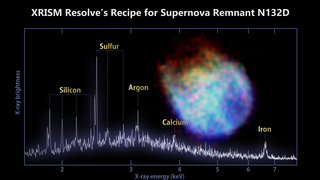XRISM's Resolve Instrument Gazes into Cygnus X-3

Cygnus X-3 is a high-mass X-ray binary system consisting of a compact object (likely a black hole) and a Wolf-Rayet star. This artist's concept shows one interpretation of the system. High-resolution X-ray spectroscopy indicates two gas components: a heavy background outflow, or wind, produced by the massive star and a turbulent structure — perhaps a wake carved into the wind — located close to the orbiting companion. As shown here, a black hole's gravity captures some of the wind into an accretion disk around it, and the disk's orbital motion sculpts a path (yellow arc) through the streaming gas. During strong outbursts, the companion emits jets of particles moving near the speed of light, seen here extending above and below the black hole.
Credit: NASA’s Goddard Space Flight Center
Alt text: Illustration of the Cygnus X-3 system
Image description: On a cloudy reddish background, a bright blue-white circle — a representation of a hot, bright, massive star — sits near the center. Wisps of blue-white border its edges, and many lines of similar color radiate from it. In the foreground at about 4 o’clock lies a yellowish ring with a black hole in its center. From the ring trails a diffuse yellow arc, sweeping from right to left and exiting at the bottom of the illustration. Extending above and below the black hole are two blue-white triangles representing particle jets.
The Japan-led XRISM (X-ray Imaging and Spectroscopy Mission) observatory has captured the most detailed portrait yet of gases flowing within Cygnus X-3, one of the most studied sources in the X-ray sky.
Cygnus X-3 is a binary that pairs a rare type of high-mass star with a compact companion — likely a black hole. The components are so close they complete an orbit in just 4.8 hours.
The star makes the system especially intriguing. It's a Wolf-Rayet star, a type that has evolved to the point where strong outflows called stellar winds strip gas from the star’s surface and drive it outward. The compact object sweeps up and heats some of this gas, causing it to emit X-rays.
XRISM (pronounced “crism”) is led by JAXA (Japan Aerospace Exploration Agency) in collaboration with NASA, along with contributions from ESA (European Space Agency). NASA and JAXA developed the mission’s microcalorimeter spectrometer instrument, named Resolve.
Observing Cygnus X-3 for 18 hours in late March, Resolve acquired a high-resolution spectrum that allows astronomers to better understand the complex gas dynamics operating there. These include outflowing gas produced by a hot, massive star, its interaction with the compact companion, and a turbulent region that may represent a wake produced by the companion as it orbits through the outrushing gas.
Cygnus X-3 is thought to lie about 32,000 light-years away in the direction of the northern constellation Cygnus. While thick dust clouds in our galaxy’s central plane obscure the system's visible light, the binary has been studied in radio, infrared, and gamma-ray light, as well as in X-rays.
The system is immersed in the star’s streaming gas, which is illuminated and ionized by X-rays from the compact companion. The gas both emits and absorbs X-rays, and many of the spectrum’s prominent peaks and valleys incorporate both aspects. Yet a simple attempt at understanding the spectrum comes up short because some of the features appear to be in the wrong place.
That’s because the rapid motion of the gas displaces these features from their normal laboratory energies due to the Doppler effect. Absorption valleys typically shift up to higher energies, indicating gas moving toward us at speeds of up to 930,000 mph (1.5 million kph). Emission peaks shift down to lower energies, indicating gas moving away from us at slower speeds.
Some spectral features displayed much stronger absorption valleys than emission peaks. The reason for this imbalance, the team concludes, is that the dynamics of the stellar wind allow the moving gas to absorb a broader range of X-ray energies emitted by the companion. The detail of the XRISM spectrum, particularly at higher energies rich in features produced by ionized iron atoms, allowed the scientists to disentangle these effects.

XRISM’s Resolve instrument has captured the most detailed X-ray spectrum yet acquired of Cygnus X-3. Peaks indicate X-rays emitted by ionized gases, and valleys form where the gases absorb X-rays; many lines are also shifted to both higher and lower energies by gas motions. Top: The full Resolve spectrum, from 2 to 8 keV (kiloelectron volts), tracks X-rays with thousands of times the energy of visible light. Some lines are labeled with the names of the elements that produced them, such as sulfur, argon, and calcium, along with Roman numerals that refer to the number of electrons these atoms have lost. Bottom: A zoom into a region of the spectrum often dominated by features produced by transitions in the innermost electron shell (K shell) of iron atoms. These features form when the atoms interact with high-energy X-rays or electrons and respond by emitting a photon at energies between 6.4 and 7 keV. These details, clearly visible for the first time with XRISM’s Resolve instrument, will help astronomers refine their understanding of this unusual system.
Credit: JAXA/NASA/XRISM Collaboration
Alt text: XRISM Resolve X-ray spectrum of Cygnus X-3
Image description: Two graphs appear on a dark blue background. The text at the top reads “XRISM Resolve Spectrum of Cygnus X-3.” The top graph, which takes up the upper third of the image, has a lighter blue background that darkens from top to bottom, an even brighter squiggly line that arcs across the graph, and yellow text such as “Sulfur XV” and Calcium XX.” X-ray brightness increases from bottom to top, and X-ray energy (measured in thousands of electron volts, or keV) increases from left to right. An orange box labeled “Area of detail” surrounds a series of peaks and valleys near the right end and identifies the region shown in the bottom graph. The lower chart is labeled “Iron K-alpha region” and shows prominent emission and absorption features produced by iron.
Short, animated version of artist's concept illustration plus spectrum.
For More Information
See NASA.gov
Credits
Please give credit for this item to:
NASA's Goddard Space Flight Center. However, individual items should be credited as indicated above.
-
Science writer
- Francis Reddy (University of Maryland College Park)
-
Illustrator
- Scott Wiessinger (eMITS)
-
Graphics
- Francis Reddy (University of Maryland College Park)
-
Scientists
- Tim Kallman (NASA/GSFC)
- Ralf Ballhausen (University of Maryland College Park)
Release date
This page was originally published on Monday, November 25, 2024.
This page was last updated on Tuesday, January 21, 2025 at 4:24 PM EST.






